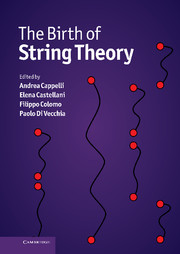Book contents
- Frontmatter
- Contents
- List of contributors
- Photographs of contributors
- Preface
- Abbreviations and acronyms
- Part I Overview
- EARLY STRING THEORY
- Part II The prehistory: the analytic S-matrix
- Part III The Dual Resonance Model
- Part IV The string
- TOWARDS MODERN STRING THEORY
- Part V Beyond the bosonic string
- Part VI The superstring
- Part VII Preparing the string renaissance
- Appendix A Theoretical tools of the Sixties
- Appendix B The Veneziano amplitude
- Appendix C From the string action to the Dual Resonance Model
- Appendix D World-sheet and target-space supersymmetry
- Appendix E The field theory limit
- Index
Appendix E - The field theory limit
Published online by Cambridge University Press: 05 May 2012
- Frontmatter
- Contents
- List of contributors
- Photographs of contributors
- Preface
- Abbreviations and acronyms
- Part I Overview
- EARLY STRING THEORY
- Part II The prehistory: the analytic S-matrix
- Part III The Dual Resonance Model
- Part IV The string
- TOWARDS MODERN STRING THEORY
- Part V Beyond the bosonic string
- Part VI The superstring
- Part VII Preparing the string renaissance
- Appendix A Theoretical tools of the Sixties
- Appendix B The Veneziano amplitude
- Appendix C From the string action to the Dual Resonance Model
- Appendix D World-sheet and target-space supersymmetry
- Appendix E The field theory limit
- Index
Summary
Introduction
The construction, from the axioms of S-matrix theory, of the Veneziano model and of its extension to N external particles, the Dual Resonance Model, made many people believe that this theory was completely different from quantum field theory. However, it soon became clear that the DRM was actually an extension of, rather than an alternative to, the various field theories, such as φ3 scalar theory [Sch71], gauge theories [NS72] and general relativity [Yon73, SS74, Yon74].
The DRM contains a parameter, the slope of the Regge trajectory α′ with dimension of (length)2, or its inverse, the string tension T = 1/(2πα′). The study of DRM amplitudes in the zero-slope (or infinite string tension) limit shows that these reduce to Feynman diagrams of specific field theories. In the string picture of the DRM, an intuitive way of understanding the zero-slope limit is the following. The string tension has the tendency to make the string collapse to a point, but, if the string is moving, for example rotating, there is also the centrifugal force, which has the opposite tendency. This means that a possible string motion results from the balance between these two forces. However, in the zero-slope limit the string tension is increasingly large, the centrifugal force cannot balance it anymore, and the string collapses to a point. In this limit, string theory becomes a theory of pointlike objects that is described by ordinary quantum field theory.
- Type
- Chapter
- Information
- The Birth of String Theory , pp. 620 - 625Publisher: Cambridge University PressPrint publication year: 2012

